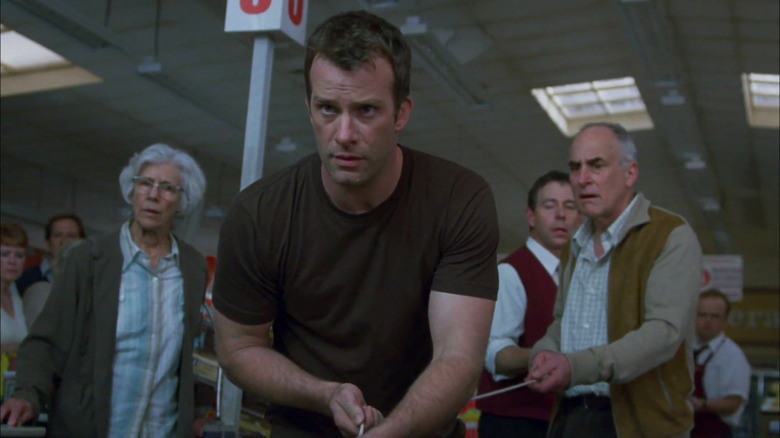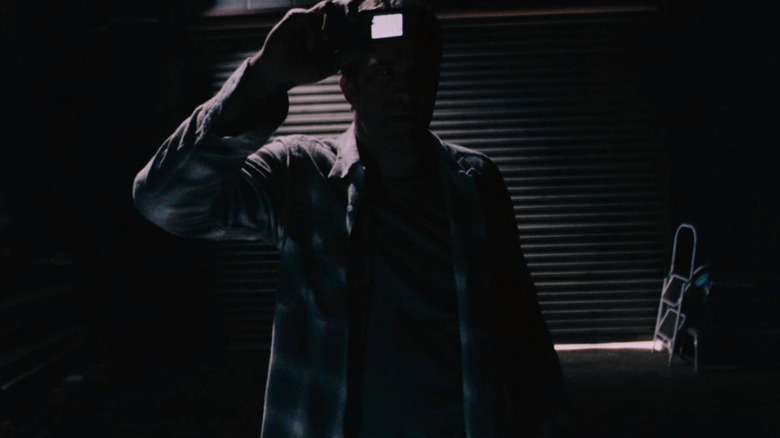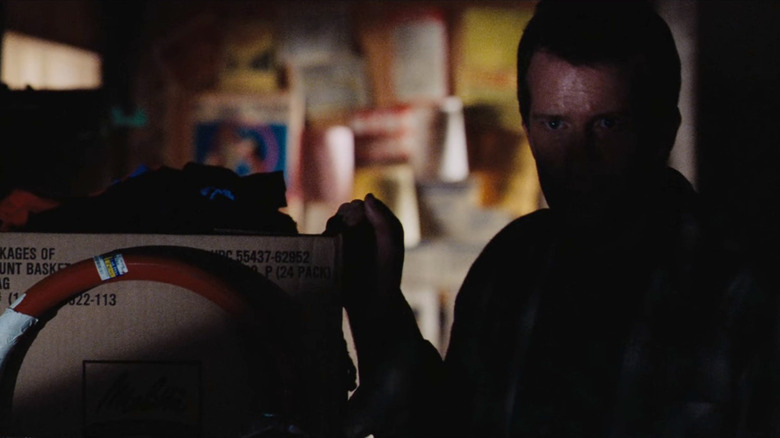The Mist's First Day Of Filming Was Almost A Total Disaster [Exclusive]
2007 was one of the last years before digital filmmaking completely consumed Hollywood. Celluloid was still the name of the game. If you were shooting digital video, you were pushing an artistic boundary, such as Michael Mann with films like "Miami Vice" or "Public Enemies." Now, it's just commonplace, where even films with the biggest budgets are shot on digital ARRI Alexa cameras. Many lament the significant loss of films shot on film (including myself) and feel the disciplines of light, color, and composition have collectively taken a sharp decline because of this technological shift.
That being said, celluloid has its limitations. In terms of the image, film's biggest hurdle is capturing in low light. All photography essentially boils down to how much light hits the camera's iris and the sensitivity of the film stock you are using. Depending on the speed of your film, it could require far more light than you realize to actually have an image where you can make out any kind of detail.
Rohn Schmidt was the cinematographer for Frank Darabont's third Stephen King adaptation "The Mist," and on the first day of the shoot, he tried a lightning technique that would really push the limits of how dark your image could be without it being completely unintelligible and underexposed. It nearly blew up in his face, and he thought he would be sent packing — either by his choice or Darabont's — shortly thereafter.
'I guess you need to replace me because that's not acceptable'
"The Mist" was shot on the now defunct Fuji Eterna film stocks with speeds of 400T and 500T. In terms of motion picture film, a 400 or 500 ASA is about as sensitive to light as you can get, meaning you wouldn't need as much light for your image compared to a 100 ASA. The first scene they shot saw Thomas Jane's character walking through the dark back storage room of the grocery store most of the film takes place in. Rohn Schmidt and Frank Darabont liked the idea of the scene just being lit by his cell phone light. In /Film's oral history of "The Mist," Schmidt said of the scene:
"We worked with the props department to rig out a slightly brighter LED on the cell phone to make that all work and it looked beautiful. It was right on the edge in terms of exposure or not, but it was very cool looking."
Well, it was a cool idea — until they saw it. After being sent off to be developed and processed, the team took a look at the dailies the following day, and they couldn't see a thing. He continued:
"It turns on and all you can see is just the white square of the cell phone. Absolute black except for this tiny little white square of a flip phone and it never gets brighter.
And we're becoming aware that slowly everyone in the room has snuck out one by one ... I said, 'Well, Frank, I guess you need to replace me because that's not acceptable.'"
Schmidt was ready to get out, thinking he couldn't cut it. He even suggested a cinematographer to replace him. Luckily, someone realized a big mistake that night.
Calibrate your screens correctly!
Remember the episode "The Long Night" from the final season of "Game of Thrones?" When that gigantic battle episode aired, so many people complained that they were unable to see what was happening on screen. It was just too dark. Of course, it isn't too dark if you are watching in an environment conducive to low-lighting and if the picture settings on your television were optimized correctly. Well, it turns out the filmmakers of "The Mist" had the exact same issue with their own movie. Schmidt goes on to say:
"Apparently, the digital projector that we were viewing these dailies on was not set up. No one had ever calibrated the projector. We sat and watched and it was beautiful. It was all there. It was spectacular.
We did reshoot that day's dailies there, although I think the original footage is what's in the film because I was so gun-shy that it was way overlit when we went back in there. I was going to make sure we could see what we needed to see there."
The margin for error in an art form dependent on light is incredibly narrow. That goes for both capturing the light and projecting it. It takes time and care to make sure an image is at its most optimal quality, and if you aren't willing to take time to ensure that, you are delivering the audience a bad experience, which they think is the fault of the filmmakers (even though it isn't). Luckily for us, this wasn't the film's premiere. Just the dailies of the first day. A bullet was dodged and a director of photography stayed employed.


